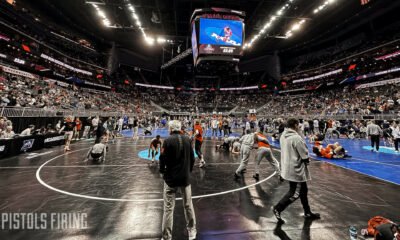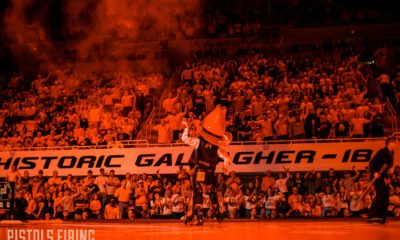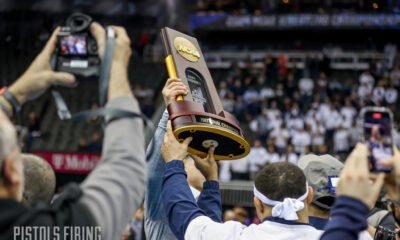Football
What’s Wrong (and Right) with OSU’s Special Teams in 2018
Enroll in Special Teams 101 with an actual expert in the field.

I, like many of you — or really anyone with functioning eyeballs — spent most of last season and the beginning of this year perplexed at Oklahoma State’s special teams woes.
An area so solid that it was an afterthought during much of Mike Gundy’s tenure (that’s probably the barometer for special teams success), had become an oft-maligned scapegoat in Stillwater.
But OSU’s specialists have since rebounded, especially after a big outing against Boise State, and have now climbed from the 100s up to No. 36 in ESPN’s special teams efficiency.
It’s easy to see how two blocked kicks (including a scoop-and-score) can boost a team’s number, but special teams is more nuanced than a specific number and easily misunderstood — especially by someone like me.
So I reached out to a bonafide expert, former OSU long snapper Josh Elias, to gain some insight into the third, least comprehended phase of football.
Elias had a lot of great info, and some ? takes. Here are some of the highlights.
I asked him about that special teams efficiency rating that we harp so much on and whether or not he puts as much credence in it.
“I think special teams efficiency is a fairly ‘ackerut’ metric,” said Elias. “I’ll buy it, I guess. I don’t think an efficiency rating could be too results-driven, given that it’s all they have to go off of. You can’t consider a team efficient because they “almost” make more plays than they actually do, or because they have potential to make more plays. I think the metric tells the story of the actual on-field performance to date.
“I don’t, however, believe that this metric can predict how a special teams unit will perform come the next game. These efficiency ratings can be, but are not always, an indicator of “good” special teams.”
That was particularly interesting to me. We seem to label a team (or unit) as good or bad based on one afternoon’s worth of evidence. That doesn’t take into account that aforementioned nuance or the especially inherent volatility of special teams. A fleeting miscalculation by a punt returner or an indiscriminate bounce of the football can have lasting ramifications on a team and a season.
Therefore, in the same way that you can’t count on multiple blocked punts in a game, you can’t necessarily pencil a team in for two dingers off of the uprights on any given road trip.
Football can be fickle, special teams is fortuitous.
As for OSU’s dip in overall special teams play over the last handful of years, Elias chalked it up to a lack of veteran leadership. That’s something I easily attach to a quarterback or a middle linebacker, but for some reason I don’t think about the effect experience has on the holder on field goals.
That 2017 team, as Elias pointed out, was devoid of the veterans that previous teams were able to boast, and it showed.
“It was the first year in a while where there wasn’t a senior starter at the long snapper, kicker, or punter positions,” Elias said. “I believe a lack of leadership and veteran presence in the locker room and on the practice field may have contributed to possibly a lack of responsibility to work the way they needed to for success. They might’ve lost their mental edge a bit.
“Each member of that unit was humbled at one point or another during last season, but I do believe that they’re the kind of people who won’t let it happen again.”
Humbling is a good word for it. Matt Ammendola, who took over for OSU’s all-time leading scorer Ben Grogan, carried his fair share of hype into 2017. He was known as “Philly” by his head coach, and as a long-distance assassin by OSU fans. His one attempt in 2016 was good from 53 yards — the third-longest in OSU history — and it looked like it would have been good from 63.
Unfortunately, Ammendola had a rough start to his redshirt sophomore season, missing a field goal each in Weeks 1 and 2 and then shanking two short kicks off of the uprights in Lubbock. The mullet was frazzled. Fans were leery.
But “Philly” finished the season 15 of 17, leading the Big 12 in scoring for the year, and led all returning Power 5 kickers in made field goals coming into 2018.
On the other leg of special teams, Oklahoma State also took a step back in 2017. After showing out as the nation’s most effective punter in 2016, Zach Sinor was not only invited to attend Big 12 Media Days, he brought with him his own advertising campaign.
But what followed on the field was a dip in production — namely touchback percentage and opponent starting field position. Sinor’s struggles were accentuated during a trip to Morgantown in which he was benched for Matt Hockett after a slow-developing punt was blocked in the end zone for 6 points the wrong way.
When the NCAA allowed schools to hire an additional 10th assistant, I was one of the first to plead for OSU to hire its first full-time special teams coordinator since Joe DeForest packed his things to work for Dana.
To me it made sense. How many defensive line coaches do you need? But I posed that question to our expert to see what he thought.
So, should OSU hire a full-time special teams coach?
“Absolutely! But I know Mike Gundy, and that Mullet knows what it is he’s doing,” said Elias. “Instead of paying one guy to do a job, he’s been able to bring two special teams minds together without paying them [a full-time assistant salary]. It seems to be “paying” off (Ok, I’ll stop).
“Patrick Cashmore and M.K. Taylor seem to have a positive impact on what the Cowboys can do in special teams. Cashmore has worked with [former special teams coach Robby] Discher at Toledo (where Discher is has been the full-time ST Coordinator since his time at OSU) and M.K. Taylor has been in a specialist/special teams room at arguably the best college football program in history (Alabama). It helps to have guys who have ‘been there.’ who know what they’re doing, and know how to teach it. The next couple years are looking up.”
With that, how does Josh view OSU’s special teams units moving forward?
“Loads of potential,” is how Elias summed up this 2017 unit. “We caught a glimpse of ‘what could be’ against Boise State. The schemes are there, the athletes are there, the coaching seems to now be there. Coverage has looked fair to good, returns have some meaning to them (when they do return them! I mean look me in the eyes and honestly tell me you don’t think Chuba should be taking the ball out from 5 yards deep!) with the athletes OSU can put back there, whether on kickoff or punt returns. I no longer have to hold my breath on punt returns thanks to Dillon Stoner’s ability to track a punt and the coordination to catch it correctly.
“It’s going to all come down to execution for the specialists. That will dictate how good these units can be. Dola has the leg and definitely has more experience and confidence going into this year, and it shows. Sam Walkingstick has been as smooth and as automatic as I’ve seen him since he joined the program, which makes everyone’s jobs ten times easier. [Jake] McClure has been dependable on kickoffs with touchbacks or with hang time. These guys need to stay the course and special teams will put [OSU] in great shape to continue winning games.”

-

 Wrestling3 days ago
Wrestling3 days agoOSU Wrestling: Thomas Gilman, Jimmy Kennedy Joining David Taylor’s Coaching Staff as Assistants
-

 Wrestling4 days ago
Wrestling4 days agoOSU Wrestling: David Taylor’s Path from Penn State Recruit to Head Coach of Cowboy Wrestling
-

 Wrestling2 days ago
Wrestling2 days ago‘We Got a Great Coach’: John Smith Speaks on David Taylor Hire
-

 Wrestling5 days ago
Wrestling5 days agoOSU Wrestling: Why New Head Coach David Taylor is Nicknamed ‘Magic Man’






